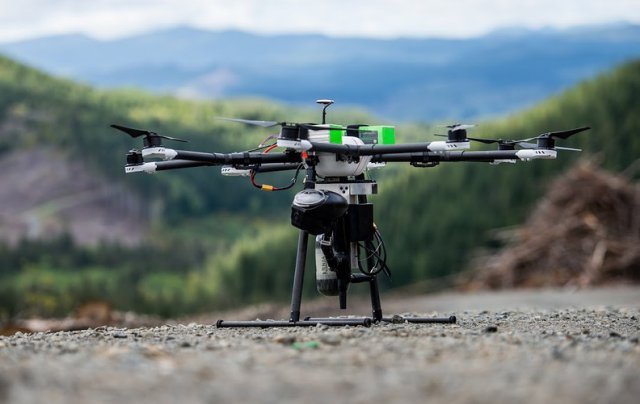Beaverton, Oregon-based drone startup DroneSeed created a drone with a device that fires seeds into the ground using compressed air in an effort to reforest the Pacific Northwest, and eventually forests around the world.
The $200 billion forestry industry depends on manual labor to plant seeds in the ground, with work crews using shovels for the chore. One human worker typically can plant 800 seeds in a day, but DroneSeed predicts its device can plant 800 seeds per hour.
Most workers on the ground in the U.S. are migrant labor, while in Canada it’s primarily seasonal workers and college students. Labor is still hard to find because the job is physically demanding. Workers have to move trees around the site, hauling trees like mountaineers in bags up hills in work that could mean a thousand back bends a day. One study says a day spent planting trees is equivalent to burning two times more calories than one would by running a marathon.
“A worker could have 3 birthday cakes and whatever Outback Steakhouse is making these days, and still have burned off more calories doing this work,” DroneSeed Chief Executive Grant Canary said.
Not surprisingly, a hard workout is not incentive to get people to do that kind of labor—and cash isn’t enough incentive either.
“You have people who will turn down the jobs for lower paying easier work elsewhere,” he said. “Not because they’re lazy, but because it’s so draining. It’s one of the hardest jobs on the planet.”
Logging has consistently been one of the most hazardous industries in the United States. In 2010, the logging industry employed 95,000 workers and accounted for 70 deaths, resulting in a fatality rate of 73.7 deaths per 100,000 workers, according to the Centers for Disease Control and Prevention. That is 21 times higher than the overall fatality rate in the U.S.

Canary would not comment on the cost of DroneSeed’s offering, but says the service offers a “significant reduction in cost” to clients needing to plant trees.
While the agriculture industry has developed tractors and other machinery to automate difficult processes, the forestry industry has struggled to develop a similar technology due to harsh and uneven terrain. Drones could be the solution, as terrain is less of a concern.
DroneSeed’s clients include Clean Water Services, a wastewater utility in parts of Oregon, which regularly plants trees to lower temperature of the waterways. It is also working to cover several million acres for one of the Northwest’s top five foresters and works internationally in Canada.
DroneSeed says its solution is good for the environment, worker safety and investors. DroneSeed’s drones currently have a flight time of about 30 minutes; after changing batteries, the drones can cover an acre within 1.5 hours.
“In the early 1900s, when the tractor came along, we saw 90% of Americans working on farms drop down to about 3%,” Canary said. “If we could have that same efficiency in planting trees, the cost could significantly be reduced.”
Goldman Sachs estimated in a March 2016 report that agriculture would be the second-largest commercial application for drones behind construction. Farms are currently using drones to monitor crop health and identify potentially problematic areas in the field, often using mounted thermal cameras.
Forestry never made the list, but likely because no one realized the potential application of drones for planting seeds. Only one other startup is similarly working to replant trees with drones: U.K.-based startup BioCarbon Engineering, led by former NASA engineer Lauren Fletcher, plans to plant 1 billion trees a year using a similar technology.
The agricultural robot market is expected to grow to $16.3 billion by 2020 from $817 million in 2013, according to a 2015 Bank of America Merrill Lynch Global Research report. The agricultural drone market has the potential to generate an additional 100,000 jobs in the U.S. and $82 billion in economic activity between 2015 and 2025, according to the report.
“There is so much parallel with what happened to precision agriculture and what is happening with us in the forestry industry with drones,” Canary said. “We see drones as forestry’s tractor.”
Source: MarketWatch


Dear Mr Canary I would like to plant a forest of coconut palms in Kerala, India, could you help me?
Anton,
Please contact DroneSeed by clicking on the link to their website in the article